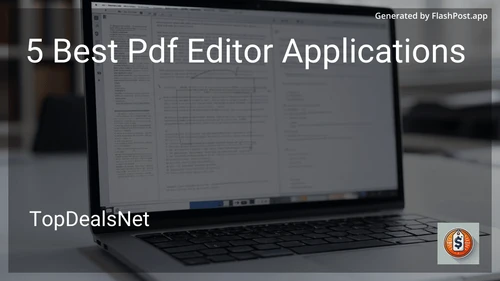Best PDF Editor Apps in January 2026

Adobe Acrobat Pro DC
- Edit text and images in PDFs
- Convert PDFs to other formats
- Merge multiple files into one PDF
- Fill and sign forms
- Add comments, annotations, and highlights

Foxit PhantomPDF
- Collaborative editing and sharing
- Document encryption and security
- Batch conversion of files to PDF
- OCR text recognition
- Create and edit PDF forms

Nitro Pro
- Edit and annotate PDFs
- Convert and merge documents
- Optical Character Recognition (OCR)
- Cloud integration with services like Google Drive and Dropbox
- Secure documents with protection and rights management

PDFelement
- Edit PDFs text and images
- Convert PDFs to Word, Excel, and other formats
- Annotation tools
- Extract data from forms
- Password protect PDF documents

Sejda PDF Editor
- Web-based PDF editor
- Add, delete or change text in PDF files
- Apply watermarks
- Split and merge PDFs
- Secure files with encryption
In today's digital age, PDF editor applications have become essential tools for both individuals and businesses. They provide the flexibility to modify and manage documents efficiently. This guide will delve into the features of PDF editors and offer insights into how to choose the best one to suit your needs.
Understanding PDF Editors
PDF (Portable Document Format) editors are software applications designed to allow users to create, view, modify, and manage PDF files. These tools are invaluable for tasks such as editing text and images, merging and splitting documents, annotating files, and more.
Key Features of a Quality PDF Editor
When searching for a top-notch PDF editor, there are several key features to consider:
1. Editing Capabilities
The core functionality of any PDF editor is its ability to manipulate PDF files. This includes editing text, adjusting images, changing fonts, and rearranging pages. A robust editor should offer intuitive tools for these tasks.
2. Annotation Tools
Annotations are critical for collaboration and review. Look for editors that provide a range of annotating options such as highlighting, commenting, drawing, and adding sticky notes.
3. Conversion Features
A good PDF editor will allow seamless conversion between PDF and other file formats like Word, Excel, PowerPoint, and images. This feature is especially beneficial for users who need to adapt documents for different platforms.
4. Security Options
Security is paramount when dealing with sensitive documents. Opt for editors that offer strong password protection, encryption, and options for redacting confidential information.
5. User Interface and Usability
The user interface should be intuitive and accessible, catering to both tech-savvy users and beginners. Editors with well-organized menus, easy-to-understand icons, and a user-friendly layout can enhance productivity.
6. Compatibility and Cloud Integration
Ensure the PDF editor is compatible with your operating system, whether it's Windows, macOS, or Linux. Moreover, integration with cloud services like Google Drive, Dropbox, and OneDrive can provide added accessibility and storage flexibility.
7. Cost-Effectiveness
While some PDF editors come with subscription plans, others offer one-time payment options. Assess your budget and compare the features provided at different price points to find a cost-effective solution.
How to Choose the Best PDF Editor for Your Needs
Choosing the ideal PDF editor requires a clear understanding of your personal or professional needs. Here’s a step-wise approach to making an informed decision:
Step 1: Identify Your Requirements
Determine the primary tasks you wish to perform with a PDF editor. Are you looking for basic editing, or do you require advanced features like OCR (Optical Character Recognition) and digital signatures?
Step 2: Evaluate Available Features
Once you've identified your needs, evaluate the features offered by various PDF editors. Create a checklist of must-have features and desirable extras.
Step 3: Consider Compatibility
Ensure the editor is compatible with your devices and supports all file formats you commonly use. This is particularly important if you work across multiple platforms.
Step 4: Trial and Feedback
Most PDF editors offer free trials or demo versions. Utilize these opportunities to test the software's usability and efficiency. Additionally, read reviews and user feedback to gain insights into other users’ experiences.
Step 5: Finalize Based on Budget
Finally, balance the features and benefits against the cost. Whether you opt for a free, open-source editor or a premium one, make sure it aligns with your financial considerations.
Conclusion
Selecting the best PDF editor application involves examining your current and anticipated future needs, assessing the software's features, compatibility, and cost. By following the steps outlined above, you can choose an editor that enhances productivity and meets your document management requirements efficiently. In the rapidly growing digital world, having the right PDF editor can make all the difference in how you handle your documents.
